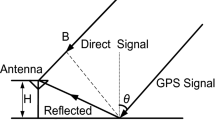Abstract
Multipath remains one of the major challenges in Global Navigation Satellite System (GNSS) positioning because it is considered the dominant source of ranging errors, which can be classified into specular and diffuse types. We present a new method using wavelets to extract the pseudorange multipath in the time domain and breaking it down into the two components. The main idea is an analysis-reconstruction approach based on application of both continuous wavelet transform (CWT) and discrete wavelet transform (DWT). The proposed procedure involves the use of L1 code-minus-carrier (CMC) observable where higher-frequency terms are isolated as residuals. CMC residuals are analyzed by applying the CWT, and we propose the scalogram as a technique for discerning time–frequency variations of the multipath signal. Unlike Fourier transform, the potential of the CWT scalogram for examining the non-stationary and multifrequency nature of the multipath is confirmed as it simultaneously allows fine detection and time localization of the most representative frequencies of the signal. This interpretation of the CWT scalogram is relevant when choosing the levels of reconstruction with DWT, allowing accurate time domain extraction of both the specular and diffuse multipath. The performance and robustness of the method and its boundary applicability are assessed. The experiment was carried out using a receiver of Campania GNSS Network. The results are given in which specular multipath error is achieved using DWT level 7 approximation component and diffuse multipath error is achieved using DWT level 6 denoised detail component.















Similar content being viewed by others
References
Aram M, El-Rabbany A, Krishnan S, Anpalagan A (2007) Single frequency multipath mitigation based on wavelet analysis. Navig Inst Navig 60(2):281–290
Bartone C, Zhang Y (2005) Real-time wavesmooth error mitigation for Global Navigation Satellite Systems. United States Patent Application Publication No. US 2005/0212696 A1
Blanco-Delgado N, de Haag MU (2011) Multipath analysis using code-minus-carrier for dynamic testing of GNSS receivers. In: Proceedings of ICL-GNSS 2011, Tampere, Finland, pp. 25–30
Braasch MS (1996) Multipath Effects. Global positioning system: theory and applications, vol I. American Institute of Aeronautics and Astronautics, Washington, DC, pp 547–568
El-Ghazouly A (2009) The aid of wavelets correlator in carrier phase multipath reduction and motion detection. In: Proceedings of ION GNSS 2009, Institute of Navigation, Savannah, Georgia, pp. 2344–2351
Elhabiby M, El-Ghazouly A, El-Sheimy N (2008) A new wavelet-based multipath mitigation technique. In: Proceedings of ION GNSS 2008, Institute of Navigation, Savannah, Georgia, pp. 625–631
El-Rabbany A (2002) Introduction to GPS: the global positioning system. Artech House, Boston London
Estey LH, Meertens CM (1999) TEQC: the multi-purpose toolkit for GPS/GLONASS data. GPS Solut 3(1):42–49
Misiti M, Misiti Y, Oppenheim G, Poggi JM (2014) Wavelet toolbox™ user’s guide R2014a. The MathWorks, Natick
Misra P, Enge P (2011) Global positioning system: signals, measurements and performance. Ganga-Jamuna Press, Lincoln
Ogaja C, Satirapod C (2007) Analysis of high-frequency multipath in 1-Hz GPS kinematic solutions. GPS Solut 11(4):269–280
Satirapod C, Rizos C (2005) Multipath mitigation by wavelet analysis for GPS base station applications. Surv Rev 38(295):2–10
Satirapod C, Ogaja C, Wang J, Rizos C (2001) An approach to GPS analysis incorporating wavelet decomposition. Artif Satell J Planet Geod 36(2):27–35
Souza EM, Monico JFG (2004) Wavelet shrinkage: high frequency multipath reduction from GPS relative positioning. GPS Solut 8(3):152–159
Souza EM, Monico JFG, Polezel WGC, Pagamisse A (2008a) An effective wavelet method to detect and mitigate low-frequency multipath effects. In: VI Hotine-Marussi Symposium of Theoretical and Computational Geodesy, International Association of Geodesy Symposia, vol 132, pp. 179–184
Souza EM, Monico JFG, Polezel WGC, Pagamisse A (2008b) Spectral analysis and low-frequency multipath mitigation for kinematic applications. In: Proceedings of PLANS IEEE/ION 2008, Monterey, California, pp. 413–417
Tranquilla J, Carr J (1991) GPS multipath field observations at land and water sites. Navig Inst Navig 37(4):393–414
Zhang Y, Bartone C (2004) Multipath mitigation in the frequency domain. In: Proceedings of PLANS IEEE 2004, Monterey, California, pp. 486–495
Zhen D (2012) MATLAB software for GPS cycle-slip processing. GPS Solut 16(2):267–272
Zhoufeng R, Li L, Zhong J, Zhao M, Shen Y (2011) A real-time cycle-slip detection and repair method for single frequency GPS receiver. In: Proceedings of IPCSIT 2011, Hong Kong, pp. 224–230
Author information
Authors and Affiliations
Corresponding author
Rights and permissions
About this article
Cite this article
Pugliano, G., Robustelli, U., Rossi, F. et al. A new method for specular and diffuse pseudorange multipath error extraction using wavelet analysis. GPS Solut 20, 499–508 (2016). https://doi.org/10.1007/s10291-015-0458-0
Received:
Accepted:
Published:
Issue Date:
DOI: https://doi.org/10.1007/s10291-015-0458-0




